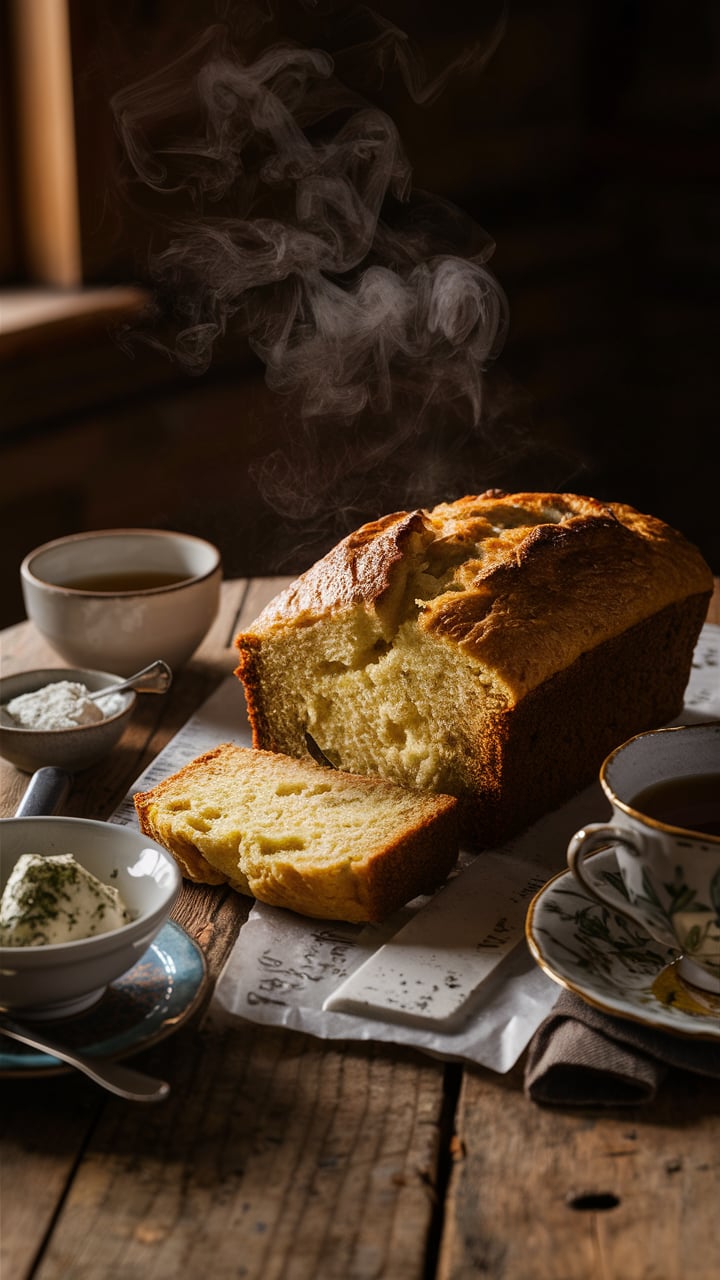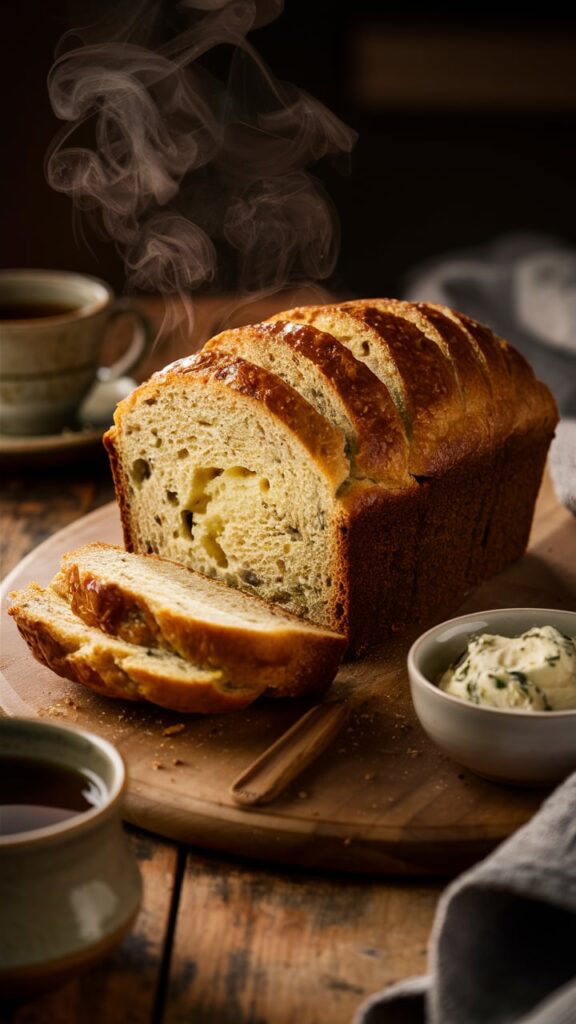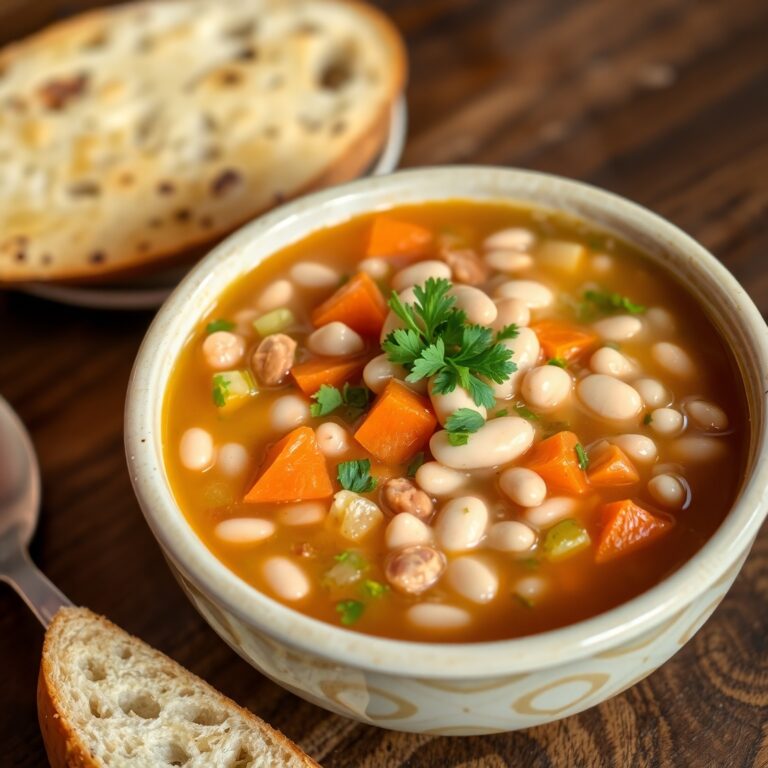Cottage Cheese Bread isn’t your average homemade loaf. This is the kind of bread you make when you want something comforting, wholesome, and just a little different from the usual. I first made it on a rainy afternoon when I craved something warm but didn’t want to bake something sweet. I had a tub of cottage cheese in the fridge and a loaf pan begging for attention.
The result? A moist, protein-rich bread with a tender crumb and just the right amount of tang. If you’re someone who enjoys experimenting in the kitchen or just wants to make a healthier bread option, this is one recipe you’ll come back to again and again.
Stick around, because you’re about to discover why this isn’t just another bread recipe — it’s a delicious twist you’ll want to share.
Why I Love This Recipe?
There’s something incredibly satisfying about baking your own bread — but when it’s also packed with protein and nutrition, it feels even better.
The beauty of Cottage Cheese Bread lies in its versatility. It’s soft but sturdy, rich in flavor yet subtle enough to pair with both sweet and savory toppings. The cottage cheese not only brings creaminess but also moisture and a slight tang that makes this loaf special.
Unlike many dense protein breads, this one bakes up light and tender thanks to the balance of flour and dairy. It’s a brilliant alternative to store-bought bread if you’re trying to boost your daily protein intake without adding unnecessary sugar or preservatives.
Whether you’re feeding a busy family, prepping for a week of healthy lunches, or just want to try something new for your Sunday brunch spread — this bread checks all the boxes.
Ingredients for Cottage Cheese Bread
You don’t need fancy ingredients to make something extraordinary.
This Cottage Cheese Bread uses simple pantry staples and fresh ingredients you likely already have. The goal is a beautifully baked loaf with a creamy texture and slightly savory depth — all made without the fuss.
Here’s what you’ll need to bring it to life:
- All-purpose flour – This forms the base of your bread. You can also use bread flour if you want a slightly chewier texture.
- Baking powder – Helps give the bread its rise and lightness.
- Salt – Enhances all the flavors, especially since cottage cheese is fairly mild.
- Eggs – Provide structure and richness.
- Cottage cheese – The star ingredient. Use full-fat for the best results, as it adds moisture and flavor.
- Milk – Keeps the batter fluid and helps with the softness of the final crumb.
- Butter (melted) – Adds a buttery finish that gives the bread a slight crisp on the crust.
- Sugar (optional) – Just a touch balances the savory notes. Not enough to make it sweet, but enough to round things out.
All ingredients should be at room temperature to ensure they blend smoothly and bake evenly.
How Much Time Will You Need?
Cottage Cheese Bread is surprisingly quick for a homemade bread.
You don’t need to worry about rising or kneading, making this a perfect beginner-friendly recipe.
- Prep time: 15 minutes
- Bake time: 50–60 minutes
- Cooling time: 20 minutes
- Total time: Around 90 minutes
That means you can make this loaf on a weeknight or during a lazy weekend afternoon — no yeast, no waiting, just mix, pour, and bake.
How to Make This Cottage Cheese Bread
The method is simple, but following the steps carefully will ensure your bread comes out perfectly soft and moist every time.
Step – 1: Preheat your oven and prep your pan
Preheat your oven to 350°F (175°C). Lightly grease a standard 9×5-inch loaf pan and line it with parchment paper for easy removal. Set it aside.
Step – 2: Mix the dry ingredients
In a large mixing bowl, whisk together the all-purpose flour, baking powder, and salt. Set aside.
Step – 3: Blend the wet ingredients
In a separate bowl or blender, add the cottage cheese, eggs, milk, and melted butter. If you’re using sugar, add that here. Blend or whisk until smooth and creamy. A blender works best to remove the curds from the cottage cheese if you want a uniform crumb.
Step – 4: Combine wet and dry ingredients
Pour the wet mixture into the dry ingredients. Stir gently with a spatula until everything is just combined. Do not overmix — stop as soon as you no longer see dry flour.
Step – 5: Transfer to the loaf pan
Pour the batter into your prepared loaf pan. Smooth the top with a spatula.
Step – 6: Bake until golden and cooked through
Place in the center of the oven and bake for 50–60 minutes, or until the top is golden brown and a toothpick inserted into the center comes out clean. The sides should slightly pull away from the pan when it’s done.
Step – 7: Cool before slicing
Allow the bread to cool in the pan for about 10 minutes, then transfer it to a wire rack. Let it cool for another 10–15 minutes before slicing. This step is crucial to help the crumb set.
Substitutions
Even if you’re missing a few ingredients, this recipe is flexible enough to adapt.
Want to make it gluten-free? Prefer a dairy-free option? Here’s how you can adjust:
- Gluten-free flour: Substitute with a 1:1 gluten-free all-purpose flour blend. Make sure it includes xanthan gum for the best texture.
- Low-fat cottage cheese: If you’re watching calories, you can use low-fat or even nonfat cottage cheese, but the texture will be a bit drier.
- Greek yogurt: No cottage cheese? Plain Greek yogurt is a solid substitute. Use an equal amount — it gives a similar tang and creaminess.
- Plant-based milk and butter: Almond milk or oat milk can be used in place of regular milk. Vegan butter works just fine, too.
- Add-ins: You can also stir in chopped herbs, grated cheese, or seeds to make it more flavorful. Think chives, garlic powder, or even a sprinkle of sunflower seeds on top.
Each of these substitutions gives the bread a slightly different personality — experiment to see which version fits your lifestyle best.
Best Side Dish of Cottage Cheese Bread

This bread is incredibly versatile, which makes it the perfect companion to a variety of meals. Here are three of the best side dishes to elevate your meal:
Tomato Basil Soup
The creamy, tangy bread pairs beautifully with the bright acidity and warmth of a tomato-based soup. Dip it in, and thank yourself later.
Avocado Egg Salad
Top a slice with mashed avocado and a soft-boiled egg for a protein-rich breakfast or lunch. The textures balance each other beautifully.
Grilled Veggie Platter
Serve slices of cottage cheese bread alongside grilled zucchini, bell peppers, and mushrooms for a colorful, healthy spread that’s picnic-perfect.
Serving and Presentation Tips
Serve this bread right, and it can steal the spotlight.
Cottage Cheese Bread may look simple, but with the right touch, it can feel like a bakery-quality loaf. When sliced warm, the crumb is soft and slightly steamy, perfect for showcasing your favorite spreads or toppings.
To serve it well:
- Slice it thick and serve with a pat of butter or herbed cream cheese. The creamy spread pairs wonderfully with the tangy undertones of the bread.
- For brunch, arrange slices on a wooden board alongside cured meats, fresh fruit, and cheeses for a rustic touch.
- If you’re hosting, lightly toast the slices and drizzle with honey or fig jam for a sweet-savory appetizer.
Serve it on a ceramic or wooden platter with fresh herbs like thyme or rosemary scattered around for visual appeal. A warm napkin-lined basket keeps the slices soft and welcoming at the table.
Tips and Tricks to Make This Recipe Even Better
Want to level it up like a pro?
Here are insider secrets that take this cottage cheese bread from great to unforgettable:
- Blend your cottage cheese. If you want a uniform crumb, blend the cottage cheese with eggs and milk. This removes curds and creates a smoother texture.
- Don’t overmix. Mix just until the flour disappears — this keeps your bread soft and prevents a tough, rubbery texture.
- Use full-fat dairy. Full-fat cottage cheese and whole milk bring richness and moisture. Low-fat versions tend to make the bread slightly dry.
- Bake it low and slow. If your oven runs hot, reduce the temp by 10 degrees and extend the bake by 5 minutes. This prevents an overbrowned crust with an undercooked center.
- Let it rest. Cooling the bread for at least 20 minutes ensures clean slices and better flavor development.
Want more protein? Add a tablespoon of hemp seeds or chia seeds to the batter without affecting taste or texture.
Common Mistakes to Avoid
Even a simple recipe can go sideways if you miss the basics. Watch out for these pitfalls:
- Skipping the parchment paper. Greasing the pan isn’t always enough — parchment helps lift the bread out cleanly without sticking.
- Using watery cottage cheese. Some brands have excess liquid. Drain slightly if yours seems too runny, or your bread may turn out gummy.
- Opening the oven too early. Wait at least 45 minutes before peeking — sudden drops in temperature can cause the center to collapse.
- Not testing doneness. A golden top doesn’t always mean it’s cooked inside. Always use the toothpick test in the center.
- Cutting too soon. Warm bread smells irresistible, but cutting into it right away can mess with the crumb. Let it cool, even if it tests your patience.
Follow these, and you’re guaranteed consistent results every time.
How to Store It
Good bread should last — and this one does.
Here’s how to keep your Cottage Cheese Bread fresh:
- At room temperature: Store in an airtight container or wrap tightly in foil. It stays soft for 2–3 days.
- In the fridge: It lasts up to a week in the refrigerator. Make sure it’s sealed well so it doesn’t dry out.
- In the freezer: For longer storage, slice the bread and wrap each piece individually in plastic wrap. Place all slices in a zip-top freezer bag. It freezes well for up to 2 months.
To reheat, toast slices or warm them in the oven at 300°F for 5–8 minutes. It revives both flavor and texture.
FAQ
Can I use low-fat cottage cheese?
Yes, but full-fat cottage cheese gives a moister, richer result. Low-fat versions may result in a drier loaf.
Can I add herbs or cheese into the batter?
Absolutely. Fresh herbs like rosemary, thyme, or even chopped spinach go beautifully. Grated sharp cheddar or parmesan makes the loaf more savory.
Can I make this gluten-free?
Yes, use a 1:1 gluten-free baking flour blend. Make sure it contains xanthan gum or add 1 tsp per cup for structure.
What can I use instead of eggs?
For an egg-free version, use 1/4 cup unsweetened applesauce or 1 tbsp flaxseed mixed with 3 tbsp water per egg.
Can I toast this bread?
Yes! It toasts beautifully. Try it with butter and garlic for a quick savory snack or honey for a sweet bite.

Cottage Cheese Bread
This Cottage Cheese Bread is a soft, savory loaf packed with protein from creamy cottage cheese and eggs. It’s quick to make — no yeast, no kneading, no rising — yet it delivers all the comfort and flavor of homemade bread. Ideal for toasting, sandwich-making, or simply enjoying warm with butter, this loaf is perfect for meal prepping or brunch spreads. With a golden crust and moist crumb, this recipe is easy enough for beginners but tasty enough to impress.
- Total Time: 1 hour 10 minutes
- Yield: 1 standard loaf
Ingredients
2 cups all-purpose flour
2 tsp baking powder
1/2 tsp salt
1 1/4 cups cottage cheese (full-fat)
2 large eggs
1/3 cup milk
1/4 cup butter, melted
1 tbsp sugar (optional)
Instructions
-
Preheat oven to 350°F (175°C). Grease and line a 9×5-inch loaf pan with parchment paper.
-
In a large bowl, whisk flour, baking powder, and salt.
-
In a blender or separate bowl, mix cottage cheese, eggs, milk, melted butter, and sugar until smooth.
-
Pour wet mixture into dry and stir until just combined. Do not overmix.
-
Transfer to the loaf pan and smooth the top.
-
Bake for 50–60 minutes, or until a toothpick inserted in the center comes out clean.
-
Cool in pan for 10 minutes, then move to a rack to cool fully before slicing.
Notes
For a creamier texture, blend the cottage cheese fully. Add herbs, shredded cheese, or spices for extra flavor.
- Prep Time: 15 minutes
- Cook Time: 55 minutes
- Category: Bread
- Method: Baking
- Cuisine: American
- Diet: Vegetarian
Nutrition
- Serving Size: 1 slice
- Calories: 210







